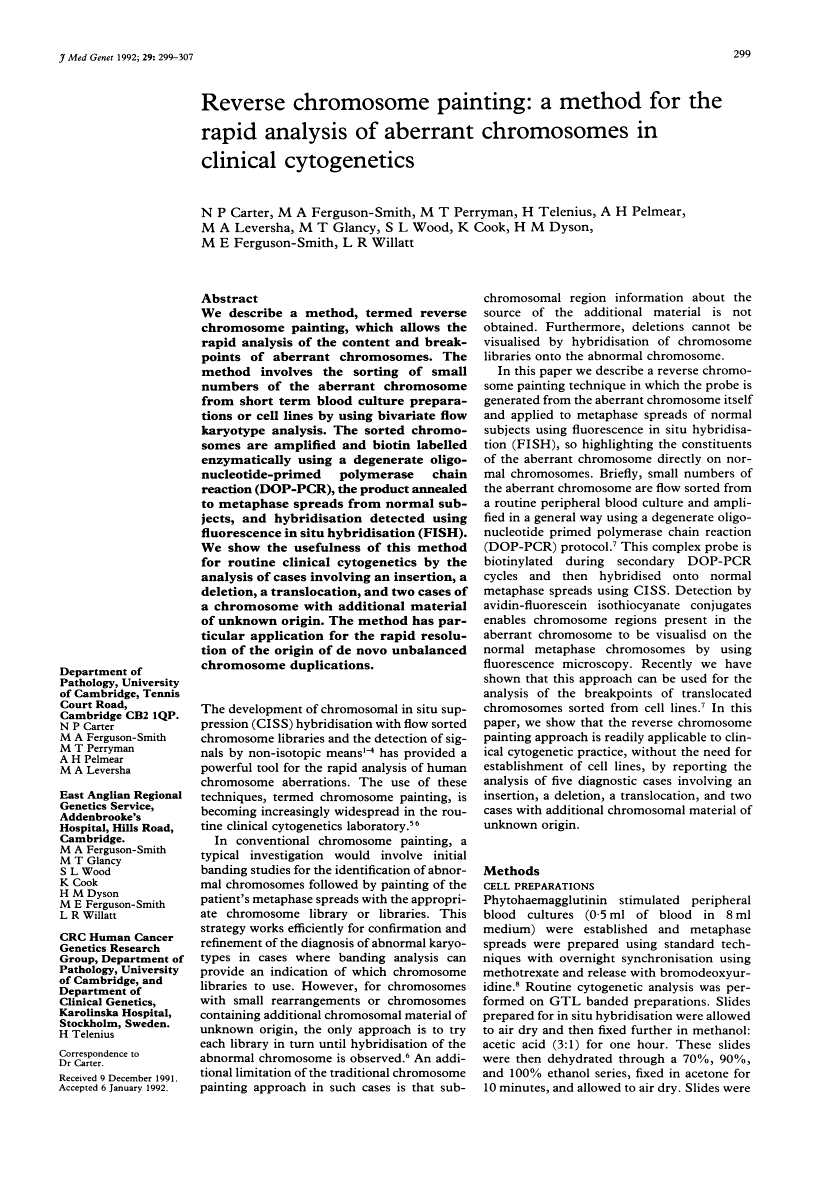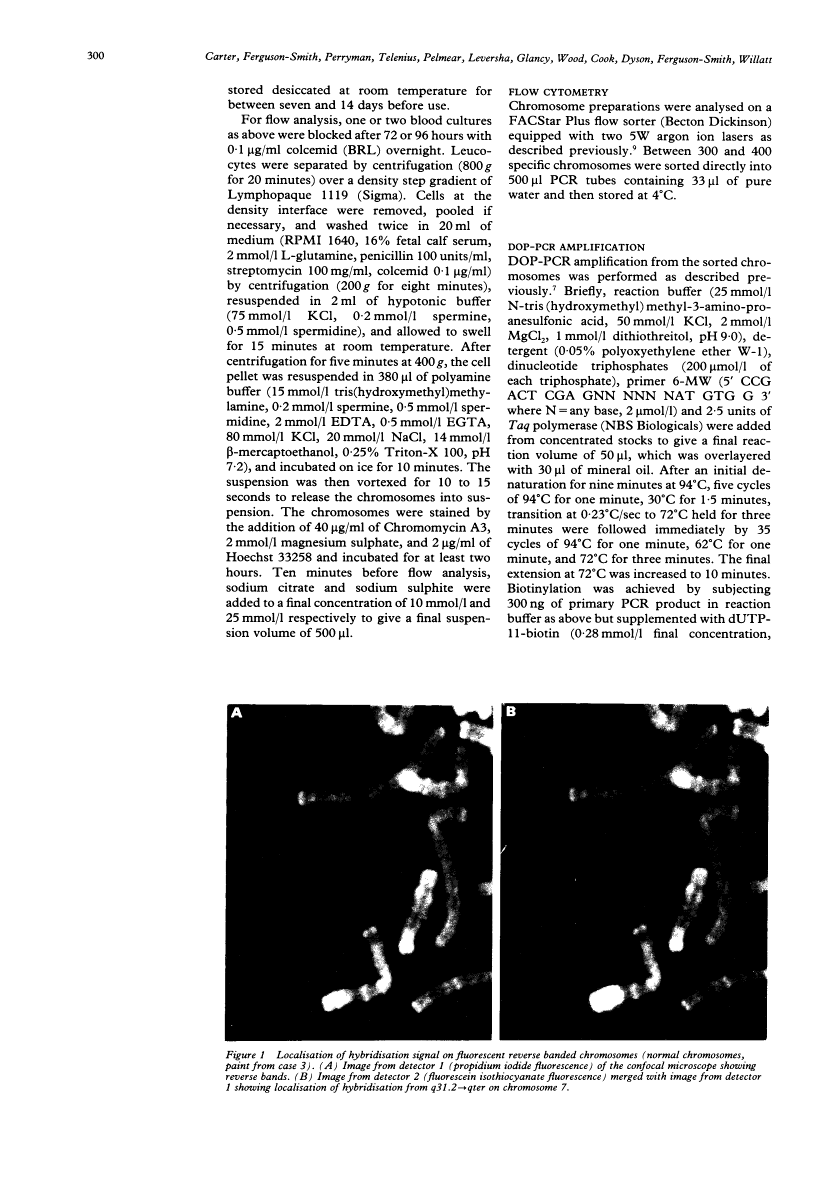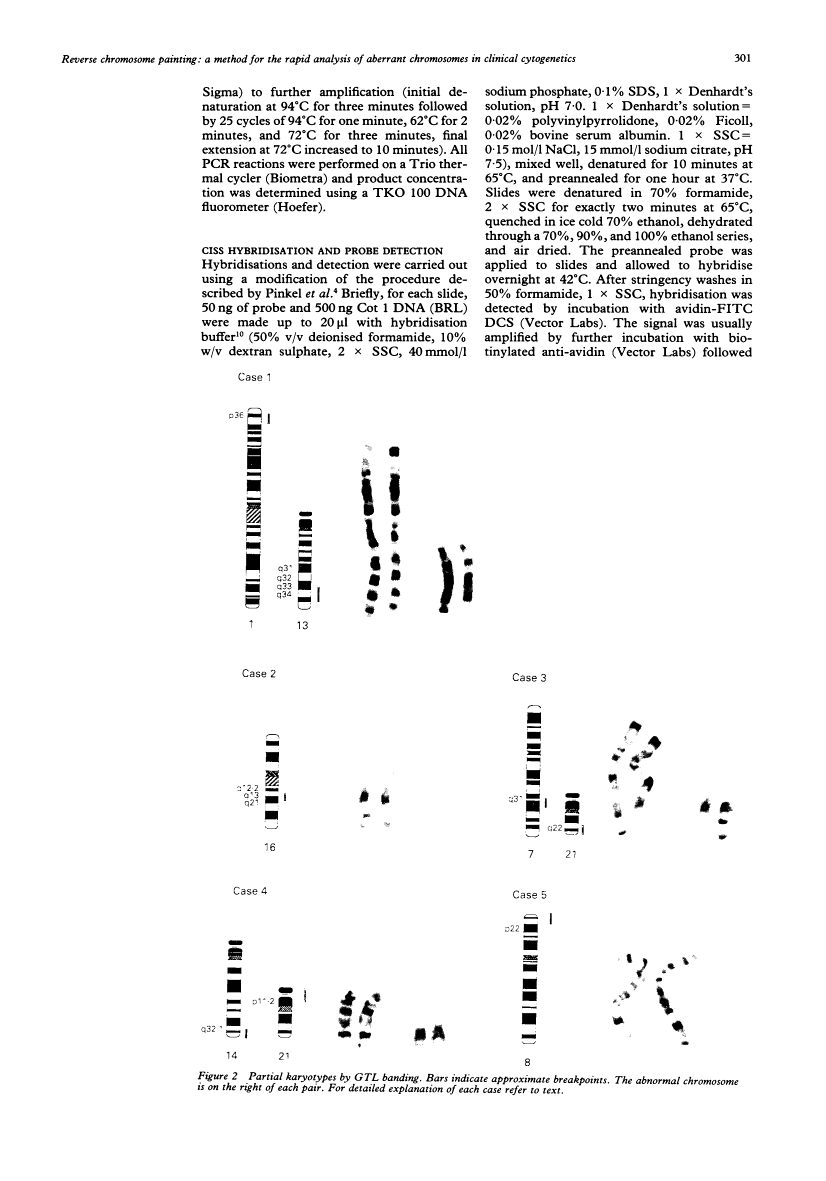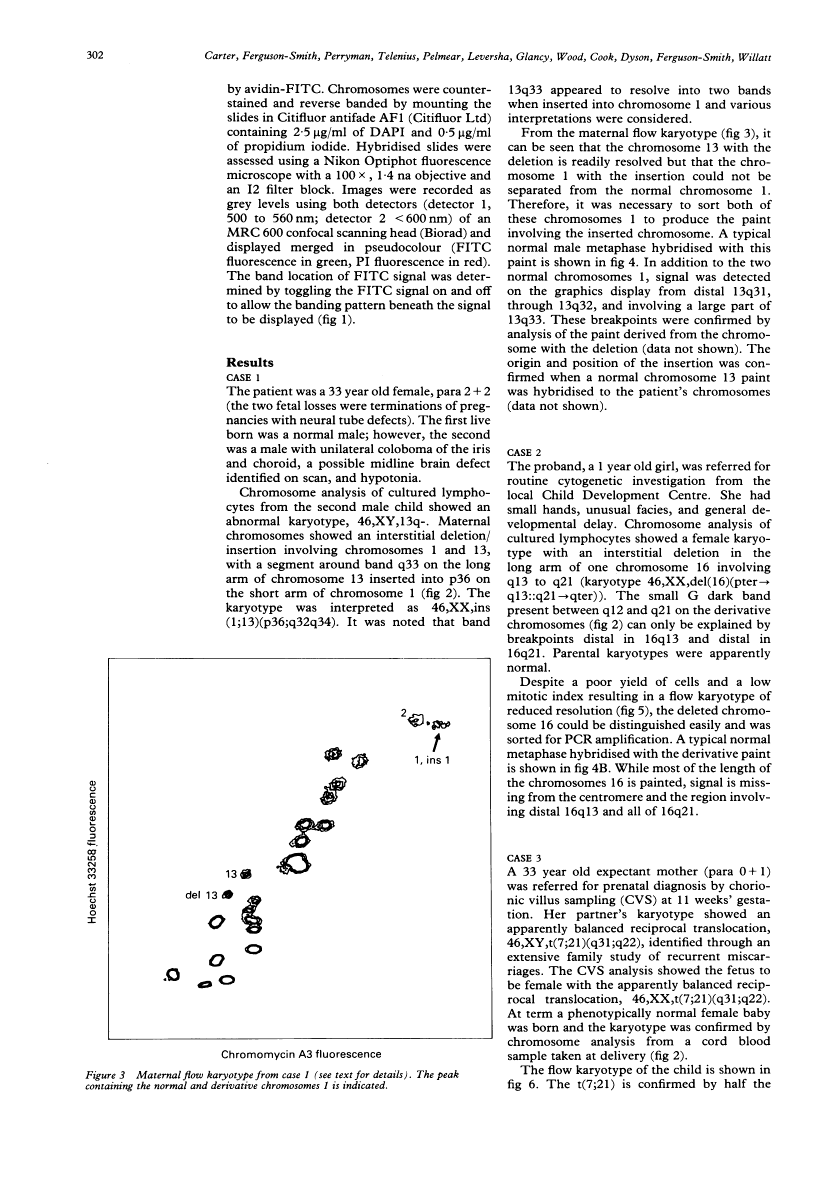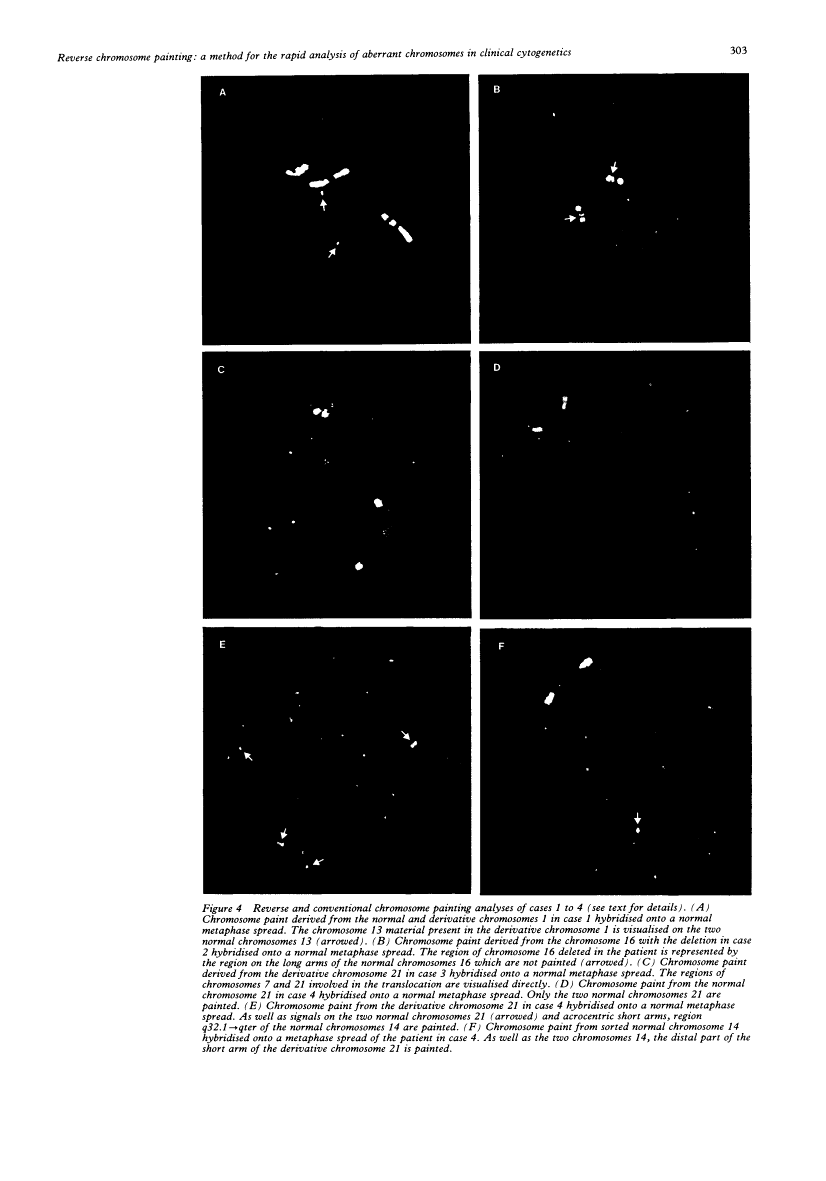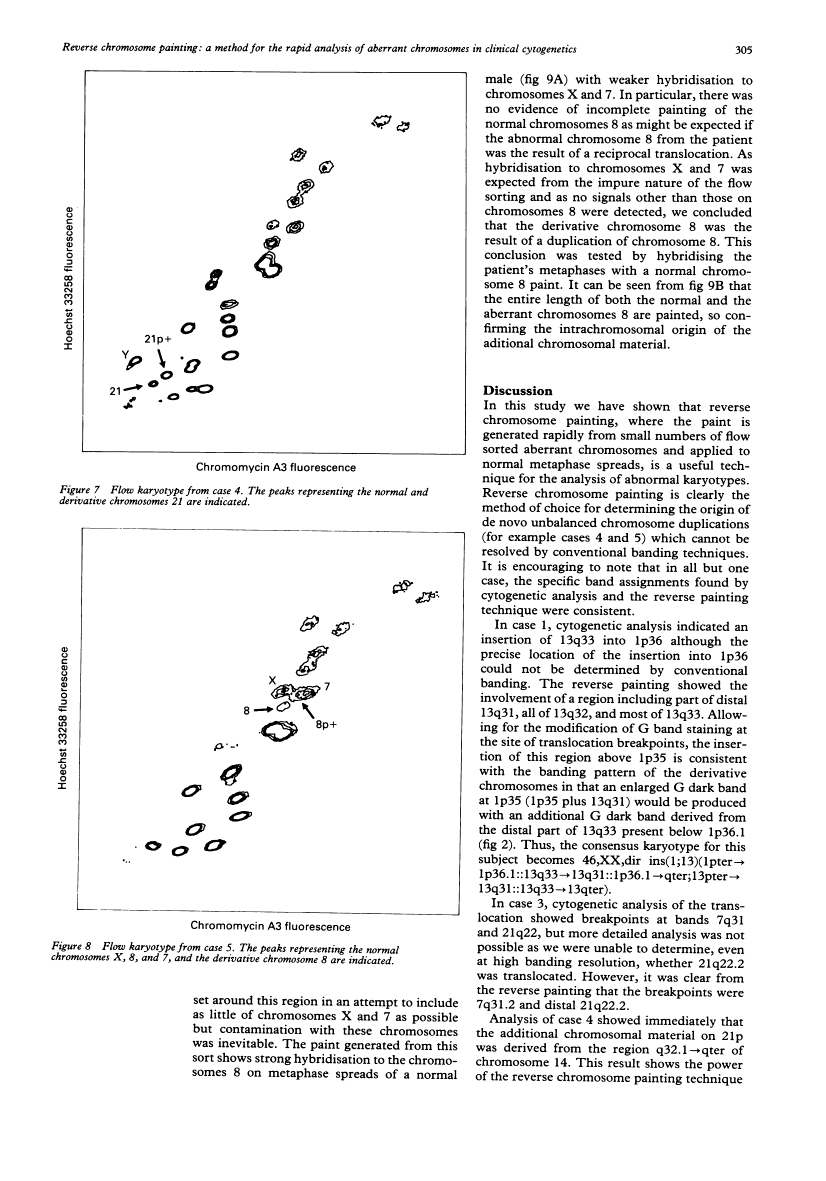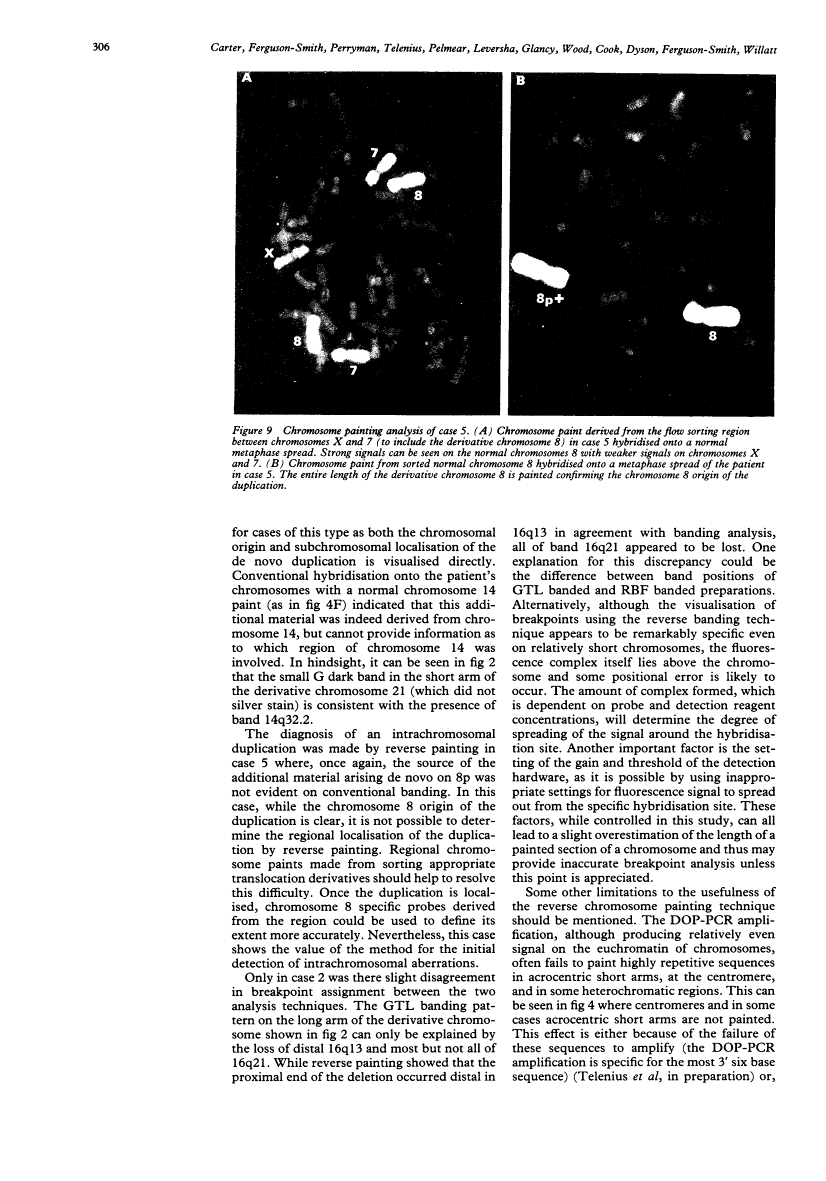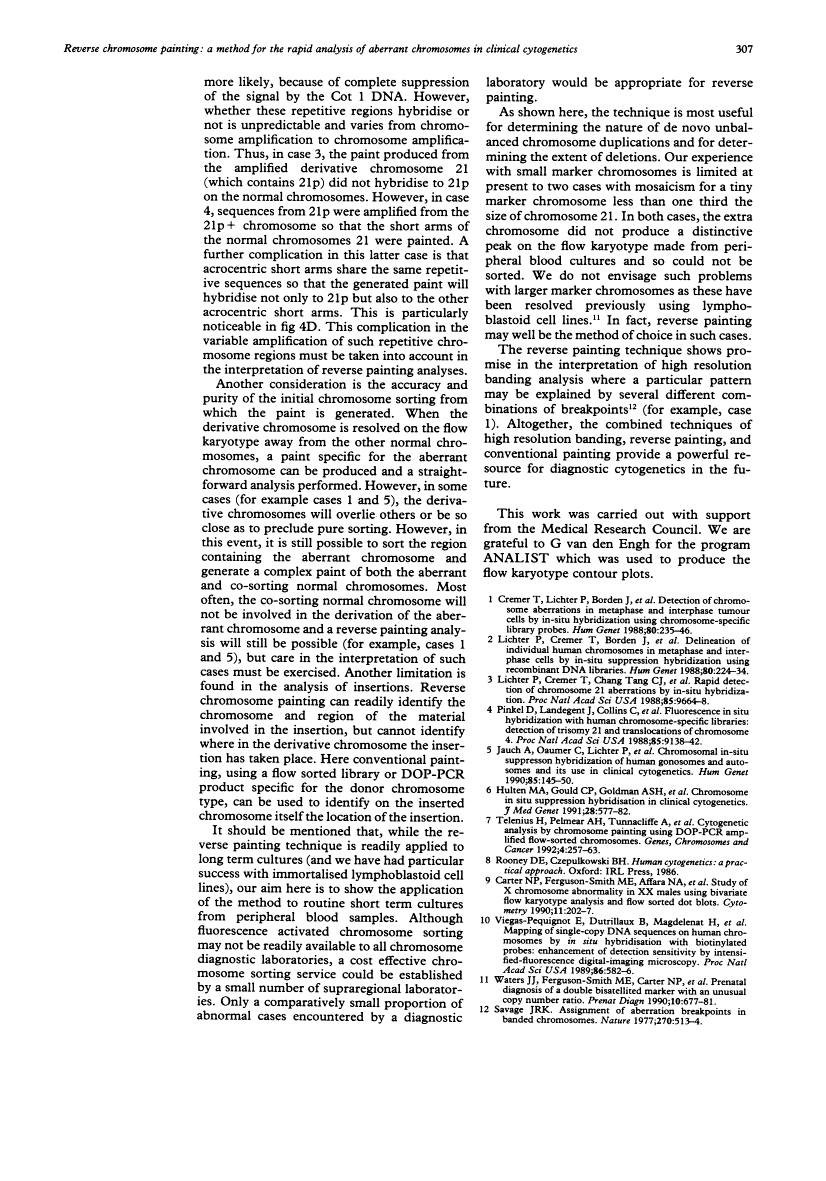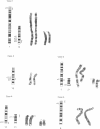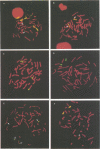Abstract
Free full text

Reverse chromosome painting: a method for the rapid analysis of aberrant chromosomes in clinical cytogenetics.
Abstract
We describe a method, termed reverse chromosome painting, which allows the rapid analysis of the content and breakpoints of aberrant chromosomes. The method involves the sorting of small numbers of the aberrant chromosome from short term blood culture preparations or cell lines by using bivariate flow karyotype analysis. The sorted chromosomes are amplified and biotin labelled enzymatically using a degenerate oligonucleotide-primed polymerase chain reaction (DOP-PCR), the product annealed to metaphase spreads from normal subjects, and hybridisation detected using fluorescence in situ hybridisation (FISH). We show the usefulness of this method for routine clinical cytogenetics by the analysis of cases involving an insertion, a deletion, a translocation, and two cases of a chromosome with additional material of unknown origin. The method has particular application for the rapid resolution of the origin of de novo unbalanced chromosome duplications.
Full text
Full text is available as a scanned copy of the original print version. Get a printable copy (PDF file) of the complete article (2.1M), or click on a page image below to browse page by page. Links to PubMed are also available for Selected References.
Images in this article
Selected References
These references are in PubMed. This may not be the complete list of references from this article.
- Cremer T, Lichter P, Borden J, Ward DC, Manuelidis L. Detection of chromosome aberrations in metaphase and interphase tumor cells by in situ hybridization using chromosome-specific library probes. Hum Genet. 1988 Nov;80(3):235–246. [Abstract] [Google Scholar]
- Lichter P, Cremer T, Borden J, Manuelidis L, Ward DC. Delineation of individual human chromosomes in metaphase and interphase cells by in situ suppression hybridization using recombinant DNA libraries. Hum Genet. 1988 Nov;80(3):224–234. [Abstract] [Google Scholar]
- Lichter P, Cremer T, Tang CJ, Watkins PC, Manuelidis L, Ward DC. Rapid detection of human chromosome 21 aberrations by in situ hybridization. Proc Natl Acad Sci U S A. 1988 Dec;85(24):9664–9668. [Europe PMC free article] [Abstract] [Google Scholar]
- Pinkel D, Landegent J, Collins C, Fuscoe J, Segraves R, Lucas J, Gray J. Fluorescence in situ hybridization with human chromosome-specific libraries: detection of trisomy 21 and translocations of chromosome 4. Proc Natl Acad Sci U S A. 1988 Dec;85(23):9138–9142. [Europe PMC free article] [Abstract] [Google Scholar]
- Jauch A, Daumer C, Lichter P, Murken J, Schroeder-Kurth T, Cremer T. Chromosomal in situ suppression hybridization of human gonosomes and autosomes and its use in clinical cytogenetics. Hum Genet. 1990 Jul;85(2):145–150. [Abstract] [Google Scholar]
- Hulten MA, Gould CP, Goldman AS, Waters JJ. Chromosome in situ suppression hybridisation in clinical cytogenetics. J Med Genet. 1991 Sep;28(9):577–582. [Europe PMC free article] [Abstract] [Google Scholar]
- Telenius H, Pelmear AH, Tunnacliffe A, Carter NP, Behmel A, Ferguson-Smith MA, Nordenskjöld M, Pfragner R, Ponder BA. Cytogenetic analysis by chromosome painting using DOP-PCR amplified flow-sorted chromosomes. Genes Chromosomes Cancer. 1992 Apr;4(3):257–263. [Abstract] [Google Scholar]
- Carter NP, Ferguson-Smith ME, Affara NA, Briggs H, Ferguson-Smith MA. Study of X chromosome abnormality in XX males using bivariate flow karyotype analysis and flow sorted dot blots. Cytometry. 1990;11(1):202–207. [Abstract] [Google Scholar]
- Viegas-Pequignot E, Dutrillaux B, Magdelenat H, Coppey-Moisan M. Mapping of single-copy DNA sequences on human chromosomes by in situ hybridization with biotinylated probes: enhancement of detection sensitivity by intensified-fluorescence digital-imaging microscopy. Proc Natl Acad Sci U S A. 1989 Jan;86(2):582–586. [Europe PMC free article] [Abstract] [Google Scholar]
- Waters JJ, Ferguson-Smith ME, Carter N, Alexander JL, Hodgson SV. Prenatal diagnosis of a double bisatellited marker with an unusual copy number ratio. Prenat Diagn. 1990 Oct;10(10):677–681. [Abstract] [Google Scholar]
- Savage JR. Assignment of aberration breakpoints in banded chromosomes. Nature. 1977 Dec 8;270(5637):513–514. [Abstract] [Google Scholar]
Associated Data
Articles from Journal of Medical Genetics are provided here courtesy of BMJ Publishing Group
Full text links
Read article at publisher's site: https://doi.org/10.1136/jmg.29.5.299
Read article for free, from open access legal sources, via Unpaywall:
https://jmg.bmj.com/content/jmedgenet/29/5/299.full.pdf
Citations & impact
Impact metrics
Citations of article over time
Alternative metrics
Smart citations by scite.ai
Explore citation contexts and check if this article has been
supported or disputed.
https://scite.ai/reports/10.1136/jmg.29.5.299
Article citations
Chromosome Analysis and Sorting Using Conventional Flow Cytometers.
Curr Protoc, 3(3):e718, 01 Mar 2023
Cited by: 1 article | PMID: 36920094 | PMCID: PMC10947383
Observations on chromosome-specific sequencing for the construction of cross-species chromosome homology maps and its resolution of human:alpaca homology.
Mol Cytogenet, 15(1):44, 07 Oct 2022
Cited by: 0 articles | PMID: 36207754 | PMCID: PMC9547437
Review Free full text in Europe PMC
Viral detection and identification in 20 min by rapid single-particle fluorescence in-situ hybridization of viral RNA.
Sci Rep, 11(1):19579, 01 Oct 2021
Cited by: 11 articles | PMID: 34599242 | PMCID: PMC8486776
A Recurrent De Novo Terminal Duplication of 14q32 in Korean Siblings Associated with Developmental Delay and Intellectual Disability, Growth Retardation, Facial Dysmorphism, and Cerebral Infarction: A Case Report and Literature Review.
Genes (Basel), 12(9):1388, 07 Sep 2021
Cited by: 3 articles | PMID: 34573370 | PMCID: PMC8472681
Review Free full text in Europe PMC
Chromosome Analysis Using Benchtop Flow Analysers and High Speed Cell Sorters.
Cytometry A, 95(3):323-331, 17 Dec 2018
Cited by: 3 articles | PMID: 30556955 | PMCID: PMC6491968
Go to all (118) article citations
Similar Articles
To arrive at the top five similar articles we use a word-weighted algorithm to compare words from the Title and Abstract of each citation.
Spectral karyotyping analysis of head and neck squamous cell carcinoma.
Laryngoscope, 111(9):1545-1550, 01 Sep 2001
Cited by: 12 articles | PMID: 11568603
Delineation of marker chromosomes by reverse chromosome painting using only a small number of DOP-PCR amplified microdissected chromosomes.
Hum Genet, 93(6):663-667, 01 Jun 1994
Cited by: 22 articles | PMID: 8005590
The development of chromosome-specific composite DNA probes for the mouse and their application to chromosome painting.
Chromosoma, 102(9):591-598, 01 Nov 1993
Cited by: 38 articles | PMID: 7508363
Cytogenetic analysis by chromosome painting.
Cytometry, 18(1):2-10, 01 Mar 1994
Cited by: 25 articles | PMID: 8082483
Review
